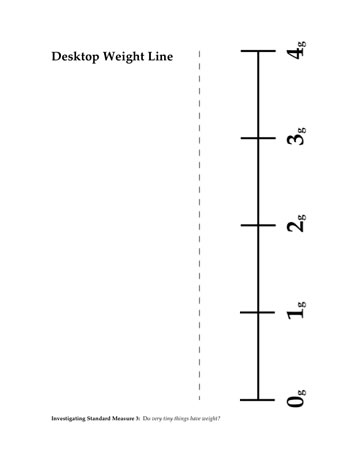Do very tiny things have weight?
Plan Investigating Standard Measures 3
Snowflakes … spider silk … poppy seeds … dust. We can see that very small things occupy space, but do they also have weight?
Formative Assessment
Do students think that very tiny things have weight?
Available online at inquiryproject.terc.edu
In this investigation, students consider the weight of objects that have no perceptible weight and are too small to move the pan balance. They make the tiny objects themselves, taking an 8–gram piece of plastic modeling clay and repeatedly cutting it in halves. After each cut, they place one half on a weight line and then cut the remainder until they have a piece too small for their hands to divide further.
By then end of the investigation, students will identify some weights between zero and 1 gram and will wrestle with the idea that even teeny, tiny things have weight.
Learning Goals
- to consider whether very tiny things have weight
- to understand that there is a place on the weight line for very tiny thingss
| Sequence of experiences | ||
|---|---|---|
| 1. Ask the question | All Class | 10 Mins |
| 2. Place small objects on a weight line | Small Groups | 20 Mins |
| 3. Discuss the weight of tiny things | All Class | 5 Mins |
| 4. Make meaning | Discussion | 10 Mins |
Materials and Preparation
For the class:- Post the investigation question in a place where all students can see it.
- Draw an oversized 4-gram weight line on a flip chart or whiteboard.
- 1 8-gram piece of plastic modeling clay, rolled to the thickness of a pencil
- 2 pan balances
- 1 5–gram weight
- 4 1–gram weights
- 4 plastic knives
- 4 small plates
- 1 desktop weight line labeled from 0 to 4 grams (from notebook)
- 4 approximately 10 grams of plastic modeling clay
Concept Cartoon

The Standard Measures Concept Cartoon is typically used as a formative assessment at the end of this investigation.
Do students think that very tiny things have weight?
Observe students as they work and listen as they make meaning to find evidence of their ideas about whether pieces of matter too small to feel, do actually weigh something.
As you interpret students' comments, listen for these ideas that commonly arise:
- If you can't feel it, it doesn't have weight.
- If you can see it must have weight.
- A tiny creature (a flea) might find this minute piece of clay weighs something.
- If you gather the tiny pieces together, you get a ball of plastic modeling clay that will weigh 8 grams.
The teacher recognized the student was in the process of developing the idea that tiny things have weight. Her next step was a question, "I heard you say that you don't think tiny things have weight but if you squeeze all the little pieces of plastic modeling clay together, you'll have a piece that weighs a gram. If the tiny pieces don't have weight, where do you think that weight comes from?"








